Sasameyuki or The Makioka Sisters: Two Tales of Four Sisters
Sasameyuki / Makioka Sisters / Light Snowfall (Yutaka Abe, 1950)
 Junichiro Tanizaki began publishing his Sasameyuki (literally "light snowfall") in serialized form in 1943. After just two installments, however, government censors informed the magazine serializing it that no further episodes should be published (inconsistent with the self-discipline needed for the war effort). Tanizaki published the complete first volume in 1944; the whole novel was finally published in 1949. The story is set in the latter half of the 1930s. It tells the story of a once very prominent Osaka family -- the Makioka family -- which had to make major adjustments after the death of the family patriarch years before (and the gradual withering away of the family business).
Junichiro Tanizaki began publishing his Sasameyuki (literally "light snowfall") in serialized form in 1943. After just two installments, however, government censors informed the magazine serializing it that no further episodes should be published (inconsistent with the self-discipline needed for the war effort). Tanizaki published the complete first volume in 1944; the whole novel was finally published in 1949. The story is set in the latter half of the 1930s. It tells the story of a once very prominent Osaka family -- the Makioka family -- which had to make major adjustments after the death of the family patriarch years before (and the gradual withering away of the family business).
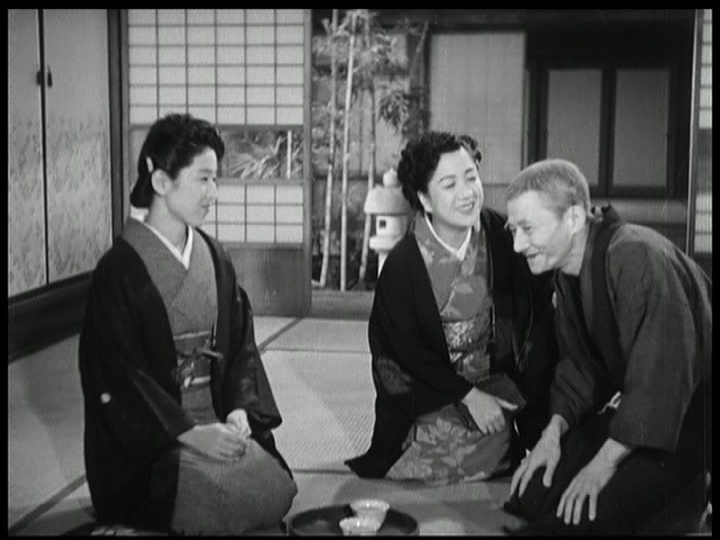 The focus is on the four sisters -- Tsuruko (nearing 40 at the outset), Sachiko (mid-30s), Yukiko (near 30) and Taeko (26). The Tsuruko is married to a rather stuffy bank executive; Sachiko to a much more urbane white collar worker. Yukiko, the beauty of the family, is still unmarried. When younger, her family had blown off several promising marriage proposals due to arrogance.
The focus is on the four sisters -- Tsuruko (nearing 40 at the outset), Sachiko (mid-30s), Yukiko (near 30) and Taeko (26). The Tsuruko is married to a rather stuffy bank executive; Sachiko to a much more urbane white collar worker. Yukiko, the beauty of the family, is still unmarried. When younger, her family had blown off several promising marriage proposals due to arrogance. 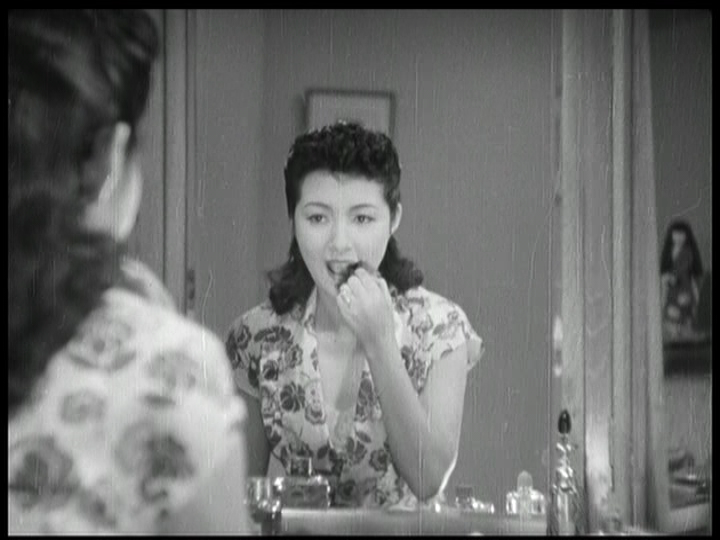 As the family's position declined, and Yukiko grew older, the range of possibilities contracted. Taeko has long wanted to marry Okubata (nicknamed "Kei-bon") -- but has not been allowed to do so -- because her older sister still remained unmarried -- and because Kei-bon (whose family owned a jewelry business) was a bit irresponsible. Yukiko and Taeko had been taken care of by Tsuruko for over ten years (after the death of their mother, 17 years prior to the period of the novel). For the past 6 years, however, they had mainly lived with Sachiko and her husband -- in a more modern suburb of Osaka.
As the family's position declined, and Yukiko grew older, the range of possibilities contracted. Taeko has long wanted to marry Okubata (nicknamed "Kei-bon") -- but has not been allowed to do so -- because her older sister still remained unmarried -- and because Kei-bon (whose family owned a jewelry business) was a bit irresponsible. Yukiko and Taeko had been taken care of by Tsuruko for over ten years (after the death of their mother, 17 years prior to the period of the novel). For the past 6 years, however, they had mainly lived with Sachiko and her husband -- in a more modern suburb of Osaka.
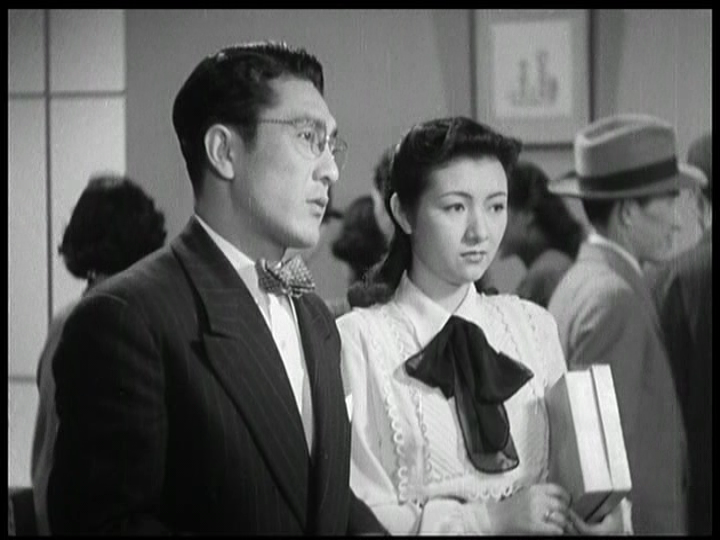 While Sachiko is (informally) the primary viewpoint character of the novel, most of the story deals with the family's attempt to marry off Yukiko suitably and Taeko's misadventures as she remains in limbo, waiting for her sister to get married. Taeko continues to maintain a closer relationship with Kei-bon than her family likes (the two had tried to elope when they were younger) and runs a doll-making workshop (and later a dress-making business as well). She also has other romantic entanglements.
While Sachiko is (informally) the primary viewpoint character of the novel, most of the story deals with the family's attempt to marry off Yukiko suitably and Taeko's misadventures as she remains in limbo, waiting for her sister to get married. Taeko continues to maintain a closer relationship with Kei-bon than her family likes (the two had tried to elope when they were younger) and runs a doll-making workshop (and later a dress-making business as well). She also has other romantic entanglements.  The first is with a photographer named Itakura, who dies due to medical malpractice, She later gets involved with a bartender named Miyoshi -- and becomes pregnant at a very inopportune time (just as Yukiko is finally on the verge of an excellent marriage). In addition to the romantic adventures of Yukiko and Taeko, the novel also looks at a succession of foreigners who live next door to Sachiko's family, the goings on of Sachiko's daughter Etsuko, and Tsuruko's move (along with her many children) from the old family mansion in Osaka to a new home in Tokyo (due to a promotion her husband receives).
The first is with a photographer named Itakura, who dies due to medical malpractice, She later gets involved with a bartender named Miyoshi -- and becomes pregnant at a very inopportune time (just as Yukiko is finally on the verge of an excellent marriage). In addition to the romantic adventures of Yukiko and Taeko, the novel also looks at a succession of foreigners who live next door to Sachiko's family, the goings on of Sachiko's daughter Etsuko, and Tsuruko's move (along with her many children) from the old family mansion in Osaka to a new home in Tokyo (due to a promotion her husband receives).
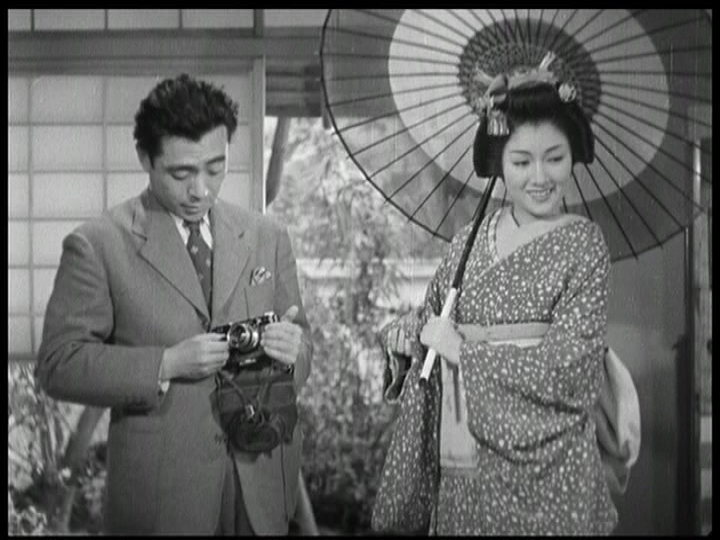 The novel's narration is quite elliptical, so it is a bit hard to tell just how much time passes from start to finish -- my guess is that it is about 3 years or so. The 500+ page novel is, as can be seen above, far too complex to allow a film to cover more than a fraction of its content. As we shall, see the two film versions I've been able to see deal very differently with the problem of adapting the book to the screen.
The novel's narration is quite elliptical, so it is a bit hard to tell just how much time passes from start to finish -- my guess is that it is about 3 years or so. The 500+ page novel is, as can be seen above, far too complex to allow a film to cover more than a fraction of its content. As we shall, see the two film versions I've been able to see deal very differently with the problem of adapting the book to the screen.
 Shintoho, a new studio that came into being as a result of the labor unrest at Toho, wasted no time in getting out it high-profile adaptation. Its director, Yutaka Abe, though now unknown in the West, had first gained fame as part of the Japanese contingent in Hollywood during the 'teens (where, as an actor, he was known as "Jack"). along with Sessue Hayakawa and Thomas Kurihara.
Shintoho, a new studio that came into being as a result of the labor unrest at Toho, wasted no time in getting out it high-profile adaptation. Its director, Yutaka Abe, though now unknown in the West, had first gained fame as part of the Japanese contingent in Hollywood during the 'teens (where, as an actor, he was known as "Jack"). along with Sessue Hayakawa and Thomas Kurihara.  After Hollywood decided it had no further use for Japanese in the early 20s, he returned to Japan, where he began a long and varied career as a director. Very little has been written about Abe in English -- and virtually none of his films have been shown in the West (in the past few decades, at least). so far as I can tell, his version of Sasameyuki in his only film released on DVD in Japan to date.
After Hollywood decided it had no further use for Japanese in the early 20s, he returned to Japan, where he began a long and varied career as a director. Very little has been written about Abe in English -- and virtually none of his films have been shown in the West (in the past few decades, at least). so far as I can tell, his version of Sasameyuki in his only film released on DVD in Japan to date.
 Abe's solution (and that of script writer Toshio Yasumi, a veteran with a long list or important scripts) to simplifying Tanizaki's complicated novel is quite straightforward -- focus almost exclusively on Taeko's story, with matters involving Yukiko and the rest of the family being presented only in a background fashion, as necessary. The centrality of Taeko in this film is further emphasized by the casting -- the most high-profile star was the actress who played Taeko -- Hideko Takamine (a star since her childhood, a pin-up girl during the war -- very popular but not yet fully established as "grown-up" actress).
Abe's solution (and that of script writer Toshio Yasumi, a veteran with a long list or important scripts) to simplifying Tanizaki's complicated novel is quite straightforward -- focus almost exclusively on Taeko's story, with matters involving Yukiko and the rest of the family being presented only in a background fashion, as necessary. The centrality of Taeko in this film is further emphasized by the casting -- the most high-profile star was the actress who played Taeko -- Hideko Takamine (a star since her childhood, a pin-up girl during the war -- very popular but not yet fully established as "grown-up" actress).
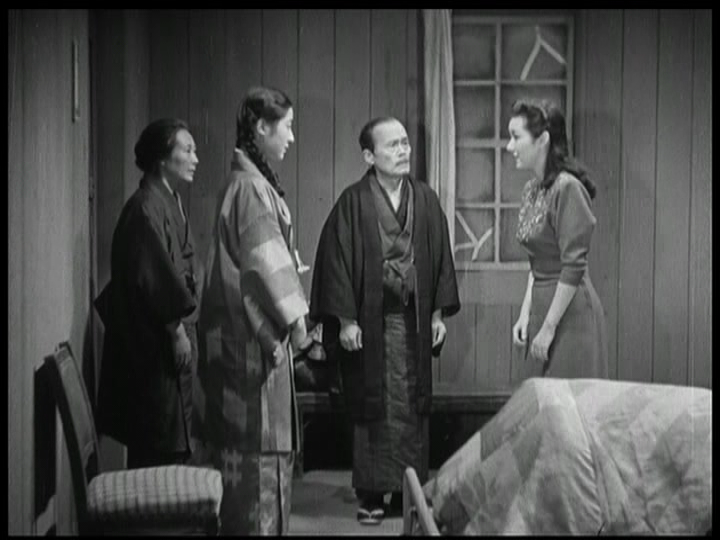 In terms of structure, insofar as it goes, Abe's adaptation is quite clear and effective. In terms of acting, it is quite convincing. Takamine is quite good here -- alternately engaging and moody (and conniving). I''m sure she appreciated a role that left her "good girl" film image in tatters -- and she seems to have made the most of it. Abe's version falls a bit flat, however, in terms of visual stylishness. Both staging and cinematography (by Susumu Yamanaka --
In terms of structure, insofar as it goes, Abe's adaptation is quite clear and effective. In terms of acting, it is quite convincing. Takamine is quite good here -- alternately engaging and moody (and conniving). I''m sure she appreciated a role that left her "good girl" film image in tatters -- and she seems to have made the most of it. Abe's version falls a bit flat, however, in terms of visual stylishness. Both staging and cinematography (by Susumu Yamanaka -- 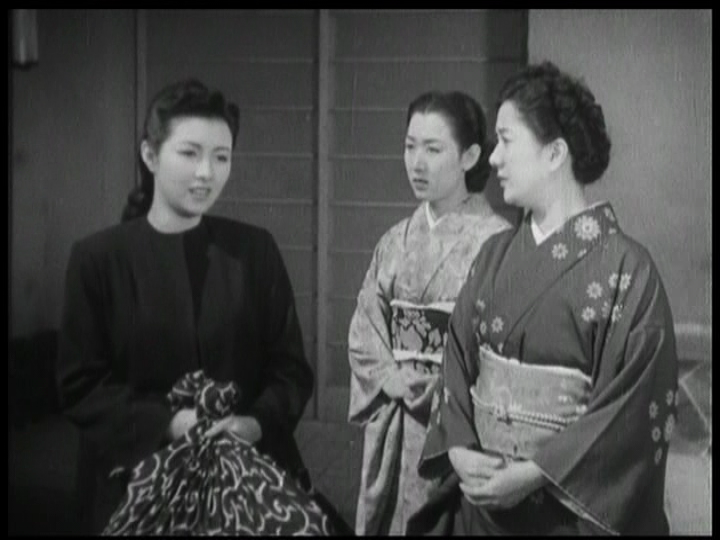 otherwise unknown to me) are not especially imaginative and are even a bit clunky at times. While Abe does try to convey a sense of the just-past time period, he does little to establish a sense of place overall. He does provide a good contrast between Sachiko's Western art moderne-ish home and Tsuruko somewhat gone-to-seed family "mansion". All in all, a decent (albeit self-limited adaptation). The new Japanese DVD is unsubbed -- but otherwise passable.
otherwise unknown to me) are not especially imaginative and are even a bit clunky at times. While Abe does try to convey a sense of the just-past time period, he does little to establish a sense of place overall. He does provide a good contrast between Sachiko's Western art moderne-ish home and Tsuruko somewhat gone-to-seed family "mansion". All in all, a decent (albeit self-limited adaptation). The new Japanese DVD is unsubbed -- but otherwise passable.
Sasame-yuki / The Makioka Sisters (Kon Ichikawa, 1983)
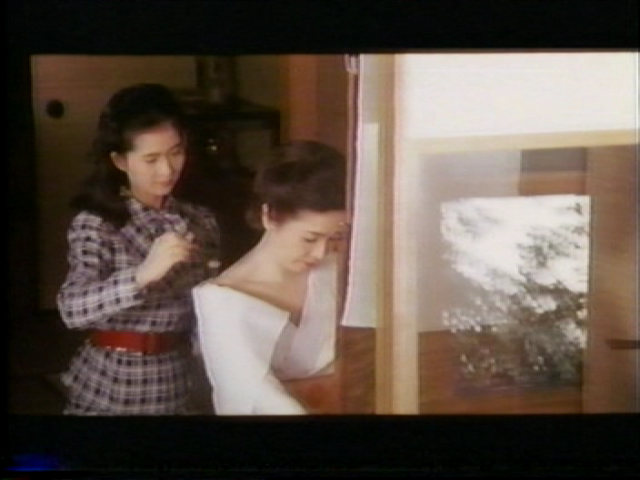 Abe's novel was re-made (by Daiei) less than a decade after Abe's version. This version, directed by Koji shima (probably best known now as an innovative science fiction film director) featured the cream of Daiei's crop of excellent performers and was shot in color. As far as I can determine,
Abe's novel was re-made (by Daiei) less than a decade after Abe's version. This version, directed by Koji shima (probably best known now as an innovative science fiction film director) featured the cream of Daiei's crop of excellent performers and was shot in color. As far as I can determine, 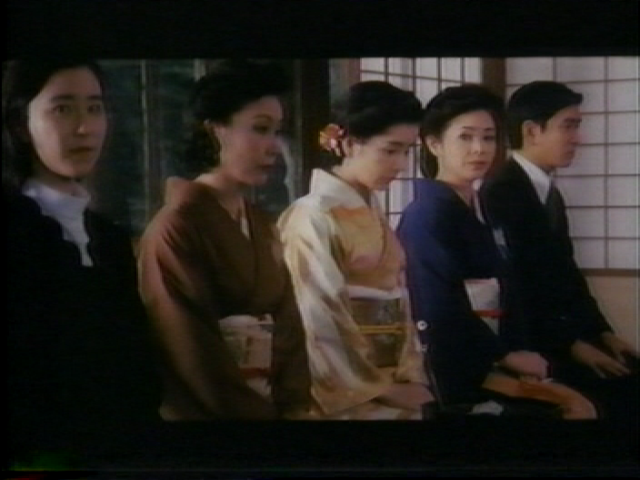 this has never been released on home video -- and I haven't seen any reports as to the quality of this version. Ichikawa's version dates from much later -- at a point when the novel would have been considered a "classic". It is certainly a far "prettier" film than Abe's -- and it tries to retain a balance between the stories of both younger sisters. Otherwise, however, it is a far less satisfactory effort.
this has never been released on home video -- and I haven't seen any reports as to the quality of this version. Ichikawa's version dates from much later -- at a point when the novel would have been considered a "classic". It is certainly a far "prettier" film than Abe's -- and it tries to retain a balance between the stories of both younger sisters. Otherwise, however, it is a far less satisfactory effort.
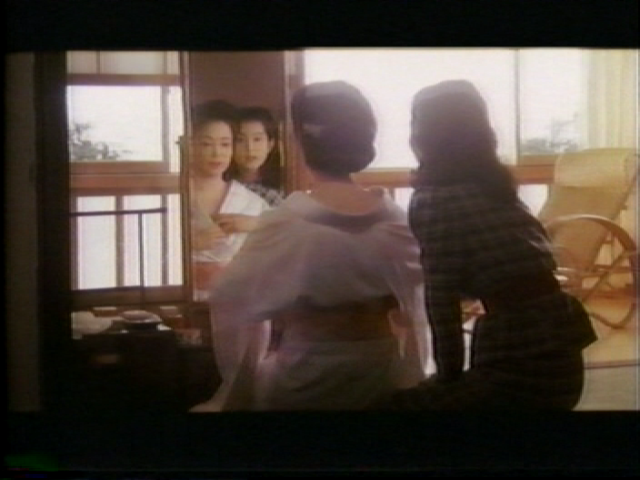 Sadly, by the time Ichikawa filmed Tanizaki's masterpiece, his brilliant script-writer spouse Natto Wada was dead (she had actually retired by the mid-60s, however). The script writer here was Shinya Hidaka, who had written scripts for a number of previous (by reputation -- utterly undistinguished) Ichikawa films. The script here is a mess -- smashing most of the key events of the novel into a very short span of time (no more than a year).
Sadly, by the time Ichikawa filmed Tanizaki's masterpiece, his brilliant script-writer spouse Natto Wada was dead (she had actually retired by the mid-60s, however). The script writer here was Shinya Hidaka, who had written scripts for a number of previous (by reputation -- utterly undistinguished) Ichikawa films. The script here is a mess -- smashing most of the key events of the novel into a very short span of time (no more than a year). 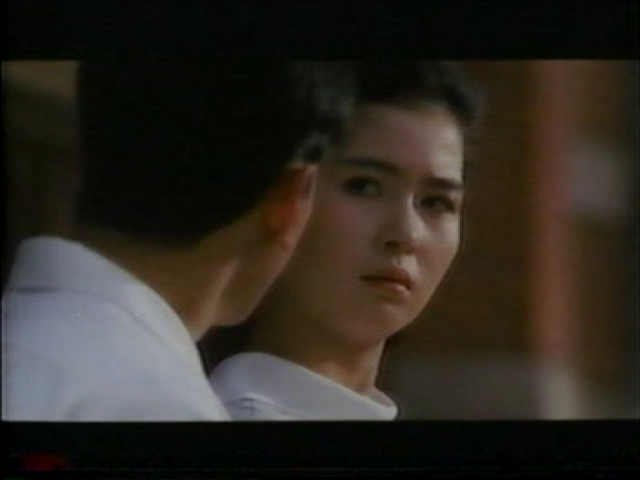 Obviously, with this such extreme compression, Taeko has no time for an illicit pregnancy (and disastrously botched obstetric care). All in all, the sense of the sisters mainly just drifting along with the tide of time is almost totally lost. And while this version does give more or less equal time to Yukiko and Taeko, it also wastes a considerable amount of time on the relationship of the two older sisters (a minor aspect of the book) -- and tries to make the eldest sister more likable than Tanizaki intended her to be. As with Abe's film, the subsidiary theme of foreign neighbors is completely missing.
Obviously, with this such extreme compression, Taeko has no time for an illicit pregnancy (and disastrously botched obstetric care). All in all, the sense of the sisters mainly just drifting along with the tide of time is almost totally lost. And while this version does give more or less equal time to Yukiko and Taeko, it also wastes a considerable amount of time on the relationship of the two older sisters (a minor aspect of the book) -- and tries to make the eldest sister more likable than Tanizaki intended her to be. As with Abe's film, the subsidiary theme of foreign neighbors is completely missing.
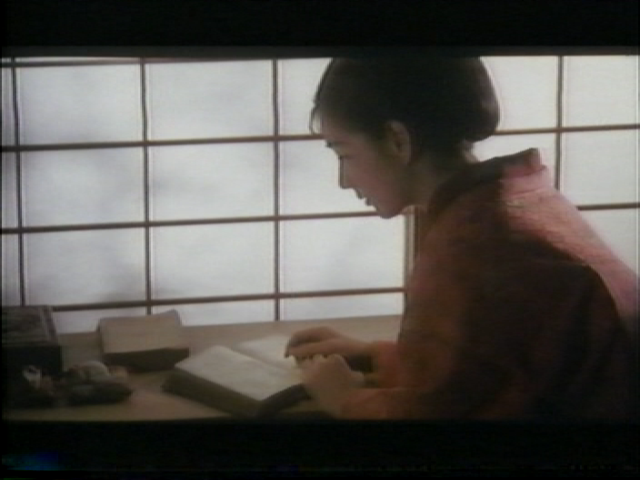 The cast here is largely a lackluster one and the performances here are almost uniformly inferior to those in the earlier version. Yuko Kotegawa's Taeko is utterly insipid compared to Takamine's. While Sayuri Yoshinaga makes a lovely-looking Yukiko, her character's part is so poorly written that Yukiko's behavior seems a bit random. As to other roles, the parts are not-well crafted -- so good performers are not able to be really successful.
The cast here is largely a lackluster one and the performances here are almost uniformly inferior to those in the earlier version. Yuko Kotegawa's Taeko is utterly insipid compared to Takamine's. While Sayuri Yoshinaga makes a lovely-looking Yukiko, her character's part is so poorly written that Yukiko's behavior seems a bit random. As to other roles, the parts are not-well crafted -- so good performers are not able to be really successful.
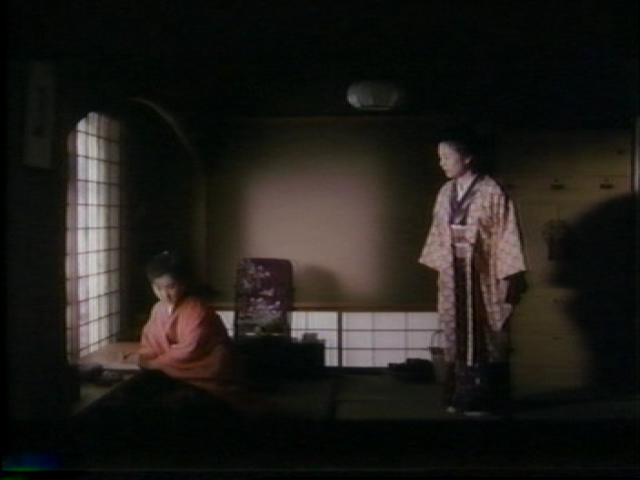 The cinematography is indeed often pretty -- but rarely beautiful. The prettiness is usually superficial -- if not saccharine. And the one visual element Abe captured wonderfully -- the striking contrast between Sachiko's modern-style home and Tsuruko's imposing but inconvenient old one -- Ichikawa botches. Similarly, where Abe (closer in time to the time in which the novel is set) captures clothing and hair styles of the late 30s fairly well, Ichikawa's film is quite sloppy in this respect.
The cinematography is indeed often pretty -- but rarely beautiful. The prettiness is usually superficial -- if not saccharine. And the one visual element Abe captured wonderfully -- the striking contrast between Sachiko's modern-style home and Tsuruko's imposing but inconvenient old one -- Ichikawa botches. Similarly, where Abe (closer in time to the time in which the novel is set) captures clothing and hair styles of the late 30s fairly well, Ichikawa's film is quite sloppy in this respect. 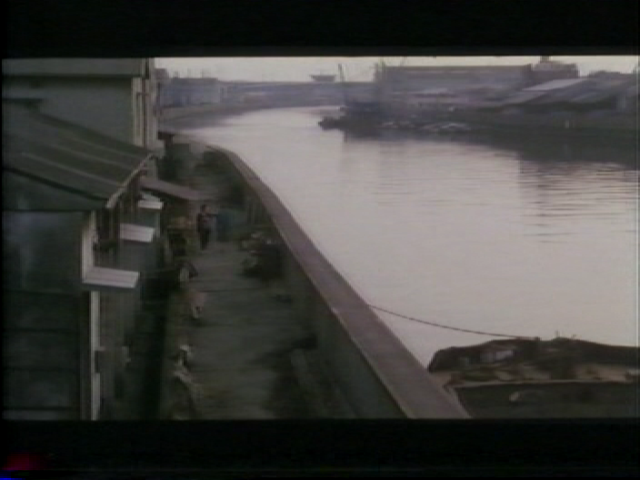 If one is not familiar with either Tanizaki's novel in particular or Japan of the late 1930s in general -- this might be a passably entertaining film. However, judged both in terms of quality of adaptation and overall cinematic quality, Ichikawa's film is sadly lacking. (Especially sadly -- as the kind individual who lent me a copy of the out-of-print subbed video is so fond of the film). I think it is safe to say that the auteur of Ichikawa's best work was the team of Wada and Ichikawa. Ichikawa alone (without even his wife's informal advice) seems to have only a limited capacity to turn out quality films.
If one is not familiar with either Tanizaki's novel in particular or Japan of the late 1930s in general -- this might be a passably entertaining film. However, judged both in terms of quality of adaptation and overall cinematic quality, Ichikawa's film is sadly lacking. (Especially sadly -- as the kind individual who lent me a copy of the out-of-print subbed video is so fond of the film). I think it is safe to say that the auteur of Ichikawa's best work was the team of Wada and Ichikawa. Ichikawa alone (without even his wife's informal advice) seems to have only a limited capacity to turn out quality films.
 Junichiro Tanizaki began publishing his Sasameyuki (literally "light snowfall") in serialized form in 1943. After just two installments, however, government censors informed the magazine serializing it that no further episodes should be published (inconsistent with the self-discipline needed for the war effort). Tanizaki published the complete first volume in 1944; the whole novel was finally published in 1949. The story is set in the latter half of the 1930s. It tells the story of a once very prominent Osaka family -- the Makioka family -- which had to make major adjustments after the death of the family patriarch years before (and the gradual withering away of the family business).
Junichiro Tanizaki began publishing his Sasameyuki (literally "light snowfall") in serialized form in 1943. After just two installments, however, government censors informed the magazine serializing it that no further episodes should be published (inconsistent with the self-discipline needed for the war effort). Tanizaki published the complete first volume in 1944; the whole novel was finally published in 1949. The story is set in the latter half of the 1930s. It tells the story of a once very prominent Osaka family -- the Makioka family -- which had to make major adjustments after the death of the family patriarch years before (and the gradual withering away of the family business). The focus is on the four sisters -- Tsuruko (nearing 40 at the outset), Sachiko (mid-30s), Yukiko (near 30) and Taeko (26). The Tsuruko is married to a rather stuffy bank executive; Sachiko to a much more urbane white collar worker. Yukiko, the beauty of the family, is still unmarried. When younger, her family had blown off several promising marriage proposals due to arrogance.
The focus is on the four sisters -- Tsuruko (nearing 40 at the outset), Sachiko (mid-30s), Yukiko (near 30) and Taeko (26). The Tsuruko is married to a rather stuffy bank executive; Sachiko to a much more urbane white collar worker. Yukiko, the beauty of the family, is still unmarried. When younger, her family had blown off several promising marriage proposals due to arrogance.  As the family's position declined, and Yukiko grew older, the range of possibilities contracted. Taeko has long wanted to marry Okubata (nicknamed "Kei-bon") -- but has not been allowed to do so -- because her older sister still remained unmarried -- and because Kei-bon (whose family owned a jewelry business) was a bit irresponsible. Yukiko and Taeko had been taken care of by Tsuruko for over ten years (after the death of their mother, 17 years prior to the period of the novel). For the past 6 years, however, they had mainly lived with Sachiko and her husband -- in a more modern suburb of Osaka.
As the family's position declined, and Yukiko grew older, the range of possibilities contracted. Taeko has long wanted to marry Okubata (nicknamed "Kei-bon") -- but has not been allowed to do so -- because her older sister still remained unmarried -- and because Kei-bon (whose family owned a jewelry business) was a bit irresponsible. Yukiko and Taeko had been taken care of by Tsuruko for over ten years (after the death of their mother, 17 years prior to the period of the novel). For the past 6 years, however, they had mainly lived with Sachiko and her husband -- in a more modern suburb of Osaka. While Sachiko is (informally) the primary viewpoint character of the novel, most of the story deals with the family's attempt to marry off Yukiko suitably and Taeko's misadventures as she remains in limbo, waiting for her sister to get married. Taeko continues to maintain a closer relationship with Kei-bon than her family likes (the two had tried to elope when they were younger) and runs a doll-making workshop (and later a dress-making business as well). She also has other romantic entanglements.
While Sachiko is (informally) the primary viewpoint character of the novel, most of the story deals with the family's attempt to marry off Yukiko suitably and Taeko's misadventures as she remains in limbo, waiting for her sister to get married. Taeko continues to maintain a closer relationship with Kei-bon than her family likes (the two had tried to elope when they were younger) and runs a doll-making workshop (and later a dress-making business as well). She also has other romantic entanglements.  The first is with a photographer named Itakura, who dies due to medical malpractice, She later gets involved with a bartender named Miyoshi -- and becomes pregnant at a very inopportune time (just as Yukiko is finally on the verge of an excellent marriage). In addition to the romantic adventures of Yukiko and Taeko, the novel also looks at a succession of foreigners who live next door to Sachiko's family, the goings on of Sachiko's daughter Etsuko, and Tsuruko's move (along with her many children) from the old family mansion in Osaka to a new home in Tokyo (due to a promotion her husband receives).
The first is with a photographer named Itakura, who dies due to medical malpractice, She later gets involved with a bartender named Miyoshi -- and becomes pregnant at a very inopportune time (just as Yukiko is finally on the verge of an excellent marriage). In addition to the romantic adventures of Yukiko and Taeko, the novel also looks at a succession of foreigners who live next door to Sachiko's family, the goings on of Sachiko's daughter Etsuko, and Tsuruko's move (along with her many children) from the old family mansion in Osaka to a new home in Tokyo (due to a promotion her husband receives). The novel's narration is quite elliptical, so it is a bit hard to tell just how much time passes from start to finish -- my guess is that it is about 3 years or so. The 500+ page novel is, as can be seen above, far too complex to allow a film to cover more than a fraction of its content. As we shall, see the two film versions I've been able to see deal very differently with the problem of adapting the book to the screen.
The novel's narration is quite elliptical, so it is a bit hard to tell just how much time passes from start to finish -- my guess is that it is about 3 years or so. The 500+ page novel is, as can be seen above, far too complex to allow a film to cover more than a fraction of its content. As we shall, see the two film versions I've been able to see deal very differently with the problem of adapting the book to the screen. Shintoho, a new studio that came into being as a result of the labor unrest at Toho, wasted no time in getting out it high-profile adaptation. Its director, Yutaka Abe, though now unknown in the West, had first gained fame as part of the Japanese contingent in Hollywood during the 'teens (where, as an actor, he was known as "Jack"). along with Sessue Hayakawa and Thomas Kurihara.
Shintoho, a new studio that came into being as a result of the labor unrest at Toho, wasted no time in getting out it high-profile adaptation. Its director, Yutaka Abe, though now unknown in the West, had first gained fame as part of the Japanese contingent in Hollywood during the 'teens (where, as an actor, he was known as "Jack"). along with Sessue Hayakawa and Thomas Kurihara.  After Hollywood decided it had no further use for Japanese in the early 20s, he returned to Japan, where he began a long and varied career as a director. Very little has been written about Abe in English -- and virtually none of his films have been shown in the West (in the past few decades, at least). so far as I can tell, his version of Sasameyuki in his only film released on DVD in Japan to date.
After Hollywood decided it had no further use for Japanese in the early 20s, he returned to Japan, where he began a long and varied career as a director. Very little has been written about Abe in English -- and virtually none of his films have been shown in the West (in the past few decades, at least). so far as I can tell, his version of Sasameyuki in his only film released on DVD in Japan to date. Abe's solution (and that of script writer Toshio Yasumi, a veteran with a long list or important scripts) to simplifying Tanizaki's complicated novel is quite straightforward -- focus almost exclusively on Taeko's story, with matters involving Yukiko and the rest of the family being presented only in a background fashion, as necessary. The centrality of Taeko in this film is further emphasized by the casting -- the most high-profile star was the actress who played Taeko -- Hideko Takamine (a star since her childhood, a pin-up girl during the war -- very popular but not yet fully established as "grown-up" actress).
Abe's solution (and that of script writer Toshio Yasumi, a veteran with a long list or important scripts) to simplifying Tanizaki's complicated novel is quite straightforward -- focus almost exclusively on Taeko's story, with matters involving Yukiko and the rest of the family being presented only in a background fashion, as necessary. The centrality of Taeko in this film is further emphasized by the casting -- the most high-profile star was the actress who played Taeko -- Hideko Takamine (a star since her childhood, a pin-up girl during the war -- very popular but not yet fully established as "grown-up" actress). In terms of structure, insofar as it goes, Abe's adaptation is quite clear and effective. In terms of acting, it is quite convincing. Takamine is quite good here -- alternately engaging and moody (and conniving). I''m sure she appreciated a role that left her "good girl" film image in tatters -- and she seems to have made the most of it. Abe's version falls a bit flat, however, in terms of visual stylishness. Both staging and cinematography (by Susumu Yamanaka --
In terms of structure, insofar as it goes, Abe's adaptation is quite clear and effective. In terms of acting, it is quite convincing. Takamine is quite good here -- alternately engaging and moody (and conniving). I''m sure she appreciated a role that left her "good girl" film image in tatters -- and she seems to have made the most of it. Abe's version falls a bit flat, however, in terms of visual stylishness. Both staging and cinematography (by Susumu Yamanaka --  otherwise unknown to me) are not especially imaginative and are even a bit clunky at times. While Abe does try to convey a sense of the just-past time period, he does little to establish a sense of place overall. He does provide a good contrast between Sachiko's Western art moderne-ish home and Tsuruko somewhat gone-to-seed family "mansion". All in all, a decent (albeit self-limited adaptation). The new Japanese DVD is unsubbed -- but otherwise passable.
otherwise unknown to me) are not especially imaginative and are even a bit clunky at times. While Abe does try to convey a sense of the just-past time period, he does little to establish a sense of place overall. He does provide a good contrast between Sachiko's Western art moderne-ish home and Tsuruko somewhat gone-to-seed family "mansion". All in all, a decent (albeit self-limited adaptation). The new Japanese DVD is unsubbed -- but otherwise passable.Sasame-yuki / The Makioka Sisters (Kon Ichikawa, 1983)
 Abe's novel was re-made (by Daiei) less than a decade after Abe's version. This version, directed by Koji shima (probably best known now as an innovative science fiction film director) featured the cream of Daiei's crop of excellent performers and was shot in color. As far as I can determine,
Abe's novel was re-made (by Daiei) less than a decade after Abe's version. This version, directed by Koji shima (probably best known now as an innovative science fiction film director) featured the cream of Daiei's crop of excellent performers and was shot in color. As far as I can determine,  this has never been released on home video -- and I haven't seen any reports as to the quality of this version. Ichikawa's version dates from much later -- at a point when the novel would have been considered a "classic". It is certainly a far "prettier" film than Abe's -- and it tries to retain a balance between the stories of both younger sisters. Otherwise, however, it is a far less satisfactory effort.
this has never been released on home video -- and I haven't seen any reports as to the quality of this version. Ichikawa's version dates from much later -- at a point when the novel would have been considered a "classic". It is certainly a far "prettier" film than Abe's -- and it tries to retain a balance between the stories of both younger sisters. Otherwise, however, it is a far less satisfactory effort. Sadly, by the time Ichikawa filmed Tanizaki's masterpiece, his brilliant script-writer spouse Natto Wada was dead (she had actually retired by the mid-60s, however). The script writer here was Shinya Hidaka, who had written scripts for a number of previous (by reputation -- utterly undistinguished) Ichikawa films. The script here is a mess -- smashing most of the key events of the novel into a very short span of time (no more than a year).
Sadly, by the time Ichikawa filmed Tanizaki's masterpiece, his brilliant script-writer spouse Natto Wada was dead (she had actually retired by the mid-60s, however). The script writer here was Shinya Hidaka, who had written scripts for a number of previous (by reputation -- utterly undistinguished) Ichikawa films. The script here is a mess -- smashing most of the key events of the novel into a very short span of time (no more than a year).  Obviously, with this such extreme compression, Taeko has no time for an illicit pregnancy (and disastrously botched obstetric care). All in all, the sense of the sisters mainly just drifting along with the tide of time is almost totally lost. And while this version does give more or less equal time to Yukiko and Taeko, it also wastes a considerable amount of time on the relationship of the two older sisters (a minor aspect of the book) -- and tries to make the eldest sister more likable than Tanizaki intended her to be. As with Abe's film, the subsidiary theme of foreign neighbors is completely missing.
Obviously, with this such extreme compression, Taeko has no time for an illicit pregnancy (and disastrously botched obstetric care). All in all, the sense of the sisters mainly just drifting along with the tide of time is almost totally lost. And while this version does give more or less equal time to Yukiko and Taeko, it also wastes a considerable amount of time on the relationship of the two older sisters (a minor aspect of the book) -- and tries to make the eldest sister more likable than Tanizaki intended her to be. As with Abe's film, the subsidiary theme of foreign neighbors is completely missing. The cast here is largely a lackluster one and the performances here are almost uniformly inferior to those in the earlier version. Yuko Kotegawa's Taeko is utterly insipid compared to Takamine's. While Sayuri Yoshinaga makes a lovely-looking Yukiko, her character's part is so poorly written that Yukiko's behavior seems a bit random. As to other roles, the parts are not-well crafted -- so good performers are not able to be really successful.
The cast here is largely a lackluster one and the performances here are almost uniformly inferior to those in the earlier version. Yuko Kotegawa's Taeko is utterly insipid compared to Takamine's. While Sayuri Yoshinaga makes a lovely-looking Yukiko, her character's part is so poorly written that Yukiko's behavior seems a bit random. As to other roles, the parts are not-well crafted -- so good performers are not able to be really successful. The cinematography is indeed often pretty -- but rarely beautiful. The prettiness is usually superficial -- if not saccharine. And the one visual element Abe captured wonderfully -- the striking contrast between Sachiko's modern-style home and Tsuruko's imposing but inconvenient old one -- Ichikawa botches. Similarly, where Abe (closer in time to the time in which the novel is set) captures clothing and hair styles of the late 30s fairly well, Ichikawa's film is quite sloppy in this respect.
The cinematography is indeed often pretty -- but rarely beautiful. The prettiness is usually superficial -- if not saccharine. And the one visual element Abe captured wonderfully -- the striking contrast between Sachiko's modern-style home and Tsuruko's imposing but inconvenient old one -- Ichikawa botches. Similarly, where Abe (closer in time to the time in which the novel is set) captures clothing and hair styles of the late 30s fairly well, Ichikawa's film is quite sloppy in this respect.  If one is not familiar with either Tanizaki's novel in particular or Japan of the late 1930s in general -- this might be a passably entertaining film. However, judged both in terms of quality of adaptation and overall cinematic quality, Ichikawa's film is sadly lacking. (Especially sadly -- as the kind individual who lent me a copy of the out-of-print subbed video is so fond of the film). I think it is safe to say that the auteur of Ichikawa's best work was the team of Wada and Ichikawa. Ichikawa alone (without even his wife's informal advice) seems to have only a limited capacity to turn out quality films.
If one is not familiar with either Tanizaki's novel in particular or Japan of the late 1930s in general -- this might be a passably entertaining film. However, judged both in terms of quality of adaptation and overall cinematic quality, Ichikawa's film is sadly lacking. (Especially sadly -- as the kind individual who lent me a copy of the out-of-print subbed video is so fond of the film). I think it is safe to say that the auteur of Ichikawa's best work was the team of Wada and Ichikawa. Ichikawa alone (without even his wife's informal advice) seems to have only a limited capacity to turn out quality films.
Comments